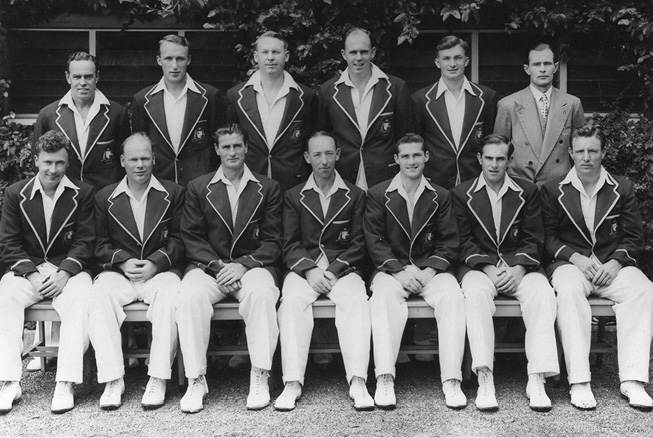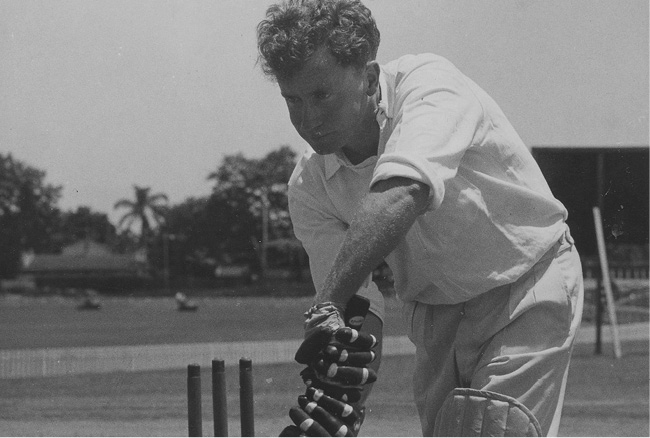
Percy: Affable Yorkshireman Percy Holmes shared one of the epic English county championship partnerships of all, 555 with Herbert Sutcliffe in 1932.
F
‘Haven’t you got a watch, Wal?’ asked the Don. ‘Every man should have a watch. How do you expect to keep appointments?’
FIVE FIVE FIVE
It may not have been ’Obbs and Sutcliffe, but it was a partnership of remarkable quality and substance. Eighty years on, the feats of Percy Holmes and Herbert Sutcliffe remain an integral part of the records of Wisden, their understanding when stealing short singles ‘positively telepathic’.
For sheer dimension and consistency, no set of openers has equalled their deeds of sharing in 74 three-figure first-wicket stands, including their astonishing 555 for Yorkshire against Essex at Leyton in 1932, still the highest stand for any wicket in a match played in England.
Holmes, from Huddersfield, and Sutcliffe, from Pudsey, were a rare combination who looked entrenched from the time they took guard. However, bar the opening Ashes match in 1921, when he top-scored on a fiery Trent Bridge wicket against Jack Gregory and Ted McDonald, Holmes never appeared against Australia, and in all was to play just seven Tests; Jack Hobbs’ long-term stature as England’s first-chosen professional, a perennial roadblock.
Despite the selection injustices – Holmes could have slotted anywhere into the top six – he maintained good humour and a perky disposition, his 40-plus county average including a triple-ton at Lord’s.
A CELEBRATION POEM TO SUTCLIFFE AND HOLMES
There’s a sportsmanlike couple more famous I guess,
For excellent teamwork than Gilbert and S,
More mighty than emperors, storied in tomes…
Of course, I’m referring to Sutcliffe and Holmes
So keen is old Yorkshire on cricket today
That a duo so striking as Bryant and May,
Or Sankey and Moody must suffer eclipse
When ‘Sutcliffe’ and ‘Holmes’ are the words on our lips.
Yes even the Dares (namely Zena and Phyllis),
Or a trio like Freeman and Hardy and Willis,
Are put in the shade, where the Yorkshireman roams,
By the millions of mentions of Sutcliffe and Holmes.
As egg is to bacon or knife is to fork
As ale is to Burton or ham is to York;
As peach is to Melba or Persian to cat,
So is Sutcliffe and Holmes when they’ve started to bat.
You cannot divide them whatever you do;
Men link them together from Leeds to Peru,
Till even in fairyland, cricketing gnomes
Breathe the magical formula – ‘Sutcliffe and Holmes’.
Holmes was 45 and increasingly suffering from lumbago the year of the famous 555 stand. At 0–423, Yorkshire could readily have declared overnight at this mid-June fixture and Holmes, who was sore, would have been perfectly happy to take his usual place at slip.
|
HIGHEST PARTNERSHIPS FOR THE FIRST WICKET |
|
|
561 |
Waheed Mirza and Mansoor Akhtar, Karachi Whites v Quetta, Karachi, 1976–77 |
|
555 |
Percy Holmes and Herbert Sutcliffe, Yorkshire v Essex, Leyton, 1932 |
|
554 |
Jack Brown and John Tunnicliffe, Yorkshire v Derbyshire, Chesterfield, 1898 |
|
Best by Australians: |
|
|
456 |
Edgar Mayne and Bill Ponsford, Victoria v Queensland, Melbourne, 1923–24 |
|
431 |
Mike Veletta and Geoff Marsh, Western Australia v South Australia, Perth, 1989–90 |
|
HERBERT SUTCLIFFE’S 100-PARTNERSHIPS HABIT |
|
• Herbert Sutcliffe was involved in 145 first wicket century stands, of which 98 were with Yorkshire: 69 with Percy Holmes as his partner, 15 with Len Hutton, six with Arthur Mitchell, four with Maurice Leyland, two with Wilfred Barber and one each with Paul Gibb and Emmott Robinson. • Thirteen of these 18 partnerships with Holmes were of 250 and over. • He and Jack Hobbs shared 26 century stands for the first wicket, including 15 in Tests, seven of which exceeded 200. |
But captain Brian Sellers, new to the role, opted for his star opening pair to bat on, no doubt fortified by seeing the crowd numbers swell in anticipation of a new world record, eclipsing the 554 held by two other Yorkies, Jack Brown and ‘Long John’ Tunnicliffe, for almost a generation.
With the prospect of the second new ball being taken immediately, Holmes and Sutcliffe opted to play as carefully as possible in the first 20 minutes before opening up again, trusting their tired muscles would be sufficiently warmed to accelerate the run-rate. The 500 was raised to great cheering, but at 522, Holmes was all but caught at slip and an anxious Sutcliffe called down the wicket: ‘Percy, do you or do you not want to go for this record?’
Having reached his first-ever triple century, Sutcliffe hit two 4s in three balls from the medium-paced Lawrie Eastman to bring up the magical 555. Years later he wrote: ‘I remember my first four in Test cricket and I remember very well the impudently desperate six with which I completed my first hundred in county cricket, but I don’t think I ever hit a ball with such joy as that delivered by Eastman that Thursday morning at Leyton.’
According to eye-witnesses, the cheering was rapturous. There were few more popular sportsmen in all England than the two long-time Yorkshire openers: Holmes, all jauntiness, combining a thumping hook shot with deft late cuts; and Sutcliffe, imperious, unhurried and fiercely determined, a man to bat for your life.
Having reached the 555, Sutcliffe’s famed focus was broken and he was bowled the very next ball, causing a minor commotion as the Yorkshire scorer did some recalculations and reckoned the stand was 554 and that the pair had only equalled the previous record, rather than surpassing it! But it was found a no-ball hadn’t been allowed for, so the 555 stood, much to everyone’s relief.
For 15 seasons Holmes and Sutcliffe averaged almost five century stands a year, including 11 in 1928. Biographer Leslie Duckworth dubbed them the ultimate run stealers. Yet they were to open together in only one Test in England – just a fortnight after their new world record.
Had Holmes possessed the same resilience as his unflappable partner, he would have played more often.
‘If only I had his patience,’ he once said.
FOR CLUB, STATE and COUNTRY
George Thoms and Colin McDonald are unique among Australian pairs, being the only duo to open up at club, interstate and national level in the same summer. The pair were teammates at Melbourne University and were averaging almost 65 runs per partnership with Victoria in 1951–52 when both were called into the Australian team for the first time in the New Year of 1952. It was to be Thoms’ only Test. A gynaecologist, he said he couldn’t afford to have his fingers injured, so retired. McDonald carried on, and in 1958–59 made more than 500 Ashes runs to be among the most-rated batsmen in the world.

Lifelong mates: George Thoms and Colin McDonald went from club to country within weeks in 1951–52, both playing their debut Tests in Sydney against the West Indies. Australia’s team, back row, left to right: Ian Johnson (12th man), Graeme Hole, Doug Ring, Bill Johnston, Richie Benaud, Alan Barnes (manager). Front: Thoms, Gil Langley, Keith Miller, Lindsay Hassett (captain), Neil Harvey, McDonald, Ray Lindwall.

One Test Wonder: Melbourne University’s George Thoms in 1951. He retired prematurely to concentrate on his work as a gynaecologist.
FUN WITH WAL
Sir Donald Bradman had the healthiest regard for the silky skills of Wally Grout, Australia’s late blooming wicketkeeper of the late 1950s and early 1960s. He liked his knockabout ways, his good humour and his passion for the game.
The Don was having lunch at the Cricketers’ Club in Sydney with Grout and noted cricket writer Ray Robinson when Grout asked him the time.
‘Haven’t you got a watch, Wal?’ asked the Don. ‘Every man should have a watch. How do you expect to keep appointments?’
Grout replied that he’d never owned a watch but would like to afford a really good one.
A week later he was involved in a Shield game in Adelaide and was handed a package during a break by the roomie. It was a gold watch from Bradman with an accompanying note thanking Grout for his contributions to Australian cricket.
In his final years in particular, Grout was very sensitive about his place in the Australian side and the form of South Australia’s wicketkeeper, the younger Barry Jarman, who would have been a Test regular virtually anywhere else in the world.
The Don had agreed to write the foreword to Grout’s soon-to-be-published autobiography My Country’s Keeper. Grout told the Don of his intention to include a few chapters about the forthcoming Australian tour of the Caribbean, to which the Don replied, ‘That’s too bad, Wal. The manager’s job has been filled and we’re not going to send a baggageman!’
The Don was well aware of Grout’s rivalry with Jarman and liked to have some fun at Grout’s expense.
In the lead-up to the selection, Grout was a guest of the Don and Lady Jessie at their Kensington home for dinner one night. Shirley Bradman asked her father had he seen Wally’s ‘wonderful catch’ to dismiss the South Australian Brian Hurn?
‘No,’ said her Dad, grinning. ‘I was in the rooms with Barry Jarman at the time!’
Grout toured as the senior keeper, Jarman again as bridesmaid.

Buddies: Wally Grout (right) and his great ally Don Bradman, who on retirement, became Australia’s frontline selector for two decades.